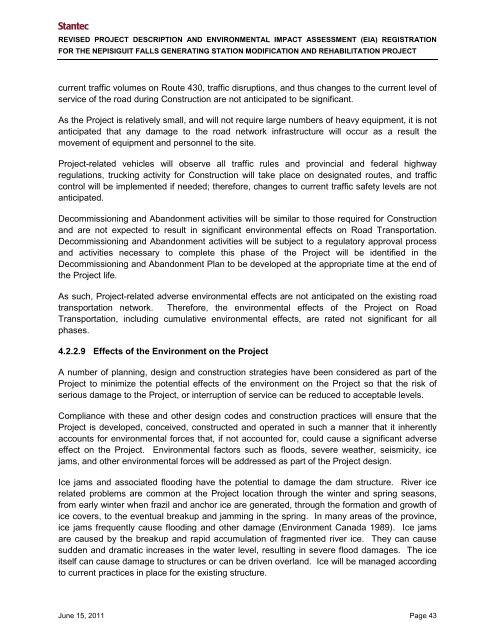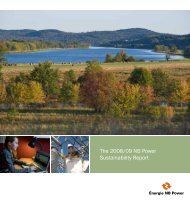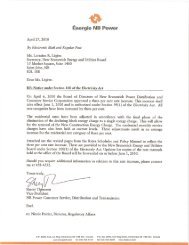Environmental Impact Assessment(EIA) Registration for the ...
Environmental Impact Assessment(EIA) Registration for the ...
Environmental Impact Assessment(EIA) Registration for the ...
You also want an ePaper? Increase the reach of your titles
YUMPU automatically turns print PDFs into web optimized ePapers that Google loves.
REVISED PROJECT DESCRIPTION AND ENVIRONMENTAL IMPACT ASSESSMENT (<strong>EIA</strong>) REGISTRATION<br />
FOR THE NEPISIGUIT FALLS GENERATING STATION MODIFICATION AND REHABILITATION PROJECT<br />
current traffic volumes on Route 430, traffic disruptions, and thus changes to <strong>the</strong> current level of<br />
service of <strong>the</strong> road during Construction are not anticipated to be significant.<br />
As <strong>the</strong> Project is relatively small, and will not require large numbers of heavy equipment, it is not<br />
anticipated that any damage to <strong>the</strong> road network infrastructure will occur as a result <strong>the</strong><br />
movement of equipment and personnel to <strong>the</strong> site.<br />
Project-related vehicles will observe all traffic rules and provincial and federal highway<br />
regulations, trucking activity <strong>for</strong> Construction will take place on designated routes, and traffic<br />
control will be implemented if needed; <strong>the</strong>re<strong>for</strong>e, changes to current traffic safety levels are not<br />
anticipated.<br />
Decommissioning and Abandonment activities will be similar to those required <strong>for</strong> Construction<br />
and are not expected to result in significant environmental effects on Road Transportation.<br />
Decommissioning and Abandonment activities will be subject to a regulatory approval process<br />
and activities necessary to complete this phase of <strong>the</strong> Project will be identified in <strong>the</strong><br />
Decommissioning and Abandonment Plan to be developed at <strong>the</strong> appropriate time at <strong>the</strong> end of<br />
<strong>the</strong> Project life.<br />
As such, Project-related adverse environmental effects are not anticipated on <strong>the</strong> existing road<br />
transportation network. There<strong>for</strong>e, <strong>the</strong> environmental effects of <strong>the</strong> Project on Road<br />
Transportation, including cumulative environmental effects, are rated not significant <strong>for</strong> all<br />
phases.<br />
4.2.2.9 Effects of <strong>the</strong> Environment on <strong>the</strong> Project<br />
A number of planning, design and construction strategies have been considered as part of <strong>the</strong><br />
Project to minimize <strong>the</strong> potential effects of <strong>the</strong> environment on <strong>the</strong> Project so that <strong>the</strong> risk of<br />
serious damage to <strong>the</strong> Project, or interruption of service can be reduced to acceptable levels.<br />
Compliance with <strong>the</strong>se and o<strong>the</strong>r design codes and construction practices will ensure that <strong>the</strong><br />
Project is developed, conceived, constructed and operated in such a manner that it inherently<br />
accounts <strong>for</strong> environmental <strong>for</strong>ces that, if not accounted <strong>for</strong>, could cause a significant adverse<br />
effect on <strong>the</strong> Project. <strong>Environmental</strong> factors such as floods, severe wea<strong>the</strong>r, seismicity, ice<br />
jams, and o<strong>the</strong>r environmental <strong>for</strong>ces will be addressed as part of <strong>the</strong> Project design.<br />
Ice jams and associated flooding have <strong>the</strong> potential to damage <strong>the</strong> dam structure. River ice<br />
related problems are common at <strong>the</strong> Project location through <strong>the</strong> winter and spring seasons,<br />
from early winter when frazil and anchor ice are generated, through <strong>the</strong> <strong>for</strong>mation and growth of<br />
ice covers, to <strong>the</strong> eventual breakup and jamming in <strong>the</strong> spring. In many areas of <strong>the</strong> province,<br />
ice jams frequently cause flooding and o<strong>the</strong>r damage (Environment Canada 1989). Ice jams<br />
are caused by <strong>the</strong> breakup and rapid accumulation of fragmented river ice. They can cause<br />
sudden and dramatic increases in <strong>the</strong> water level, resulting in severe flood damages. The ice<br />
itself can cause damage to structures or can be driven overland. Ice will be managed according<br />
to current practices in place <strong>for</strong> <strong>the</strong> existing structure.<br />
June 15, 2011 Page 43










